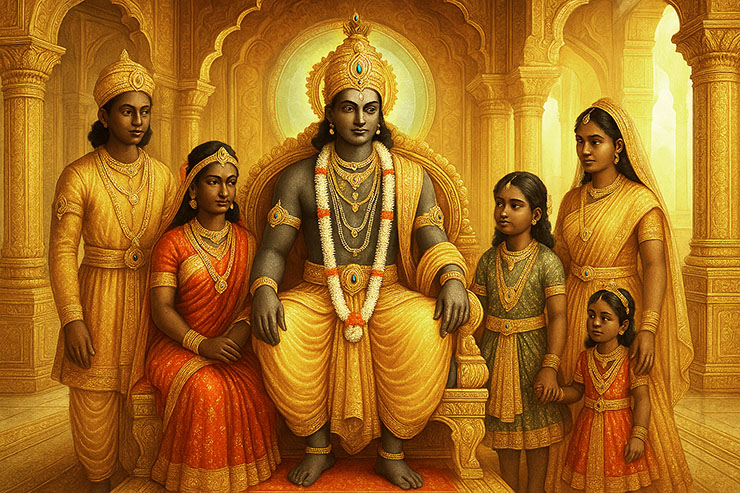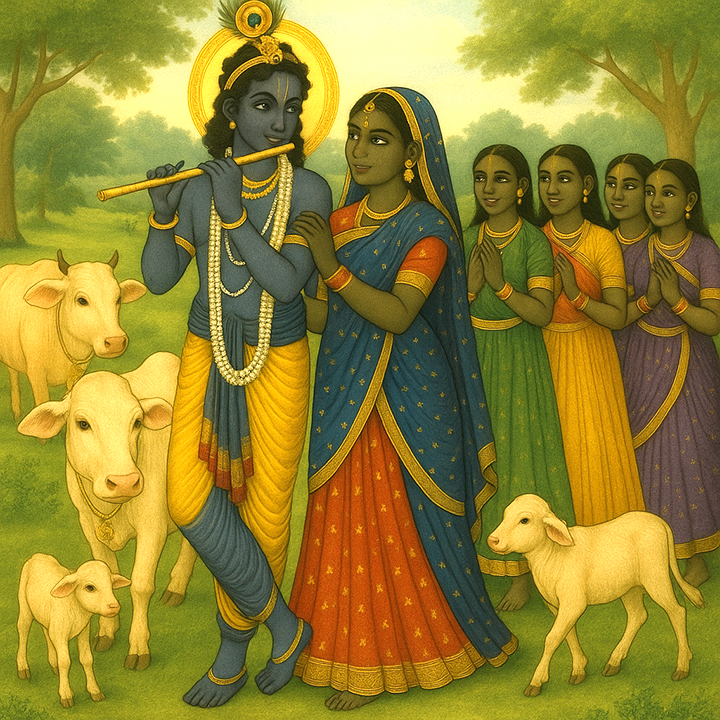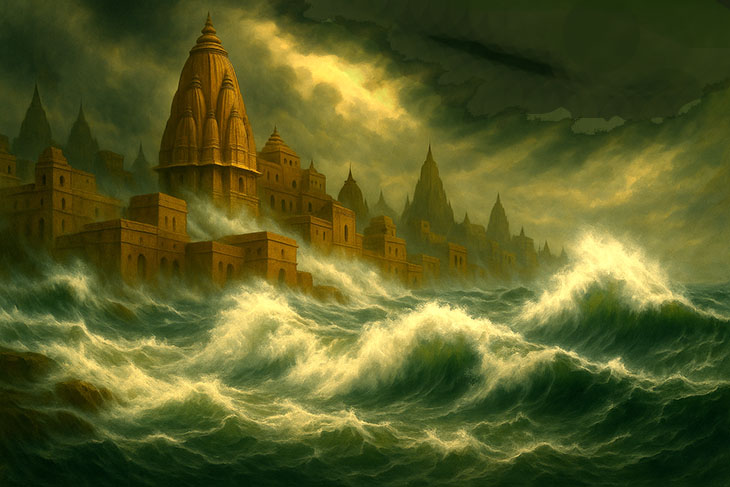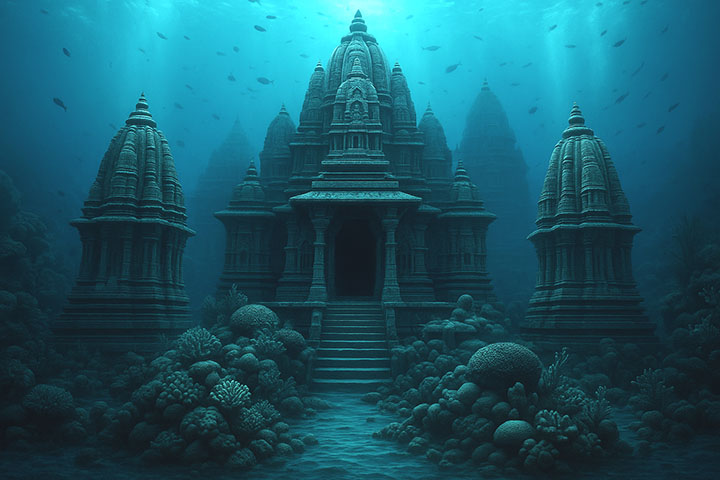
Krishna leaves Vrindavan
KRISHNA AND BROTHER BALARAMA LEAVE RADHA AND VRINDAVAN
Earlier in life, Krishna and Balarama had studied at the ashram of Sage Sandipani in Avanti (modern Ujjain)—a period typically placed after their return from Vrindavan and before the slaying of Kamsa.
After Kamsa’s death and before the building of Dwarka, Krishna entered a more mature, reflective phase of his divine mission. Some puranic and folk traditions suggest:. Krishna withdrew from active engagement and spent time in solitude, meditating on dharma). During this time, he may have consulted other sages and rishis, possibly in forested or hilly areas near Mount Raivataka (modern Girnar hills in Gujarat).
-------------
Conflict with Jarasandha and the Decision to Migrate
Jarasandha attacked Mathura 17 times. Despite Krishna and Balarama’s success in repelling him, it became clear that defending Mathura endangered the Yadavas.. Krishna thus decided to move the entire population away from the Mathura battlefield.
Westward Migration via the Raivataka Hills
Krishna led the migration of the Yadava clan across the subcontinent, stopping temporarily in the Raivataka hills near Mount Girnar (modern Junagadh). It was here that the Yadavas regrouped and rested.
With the help of divine architect Vishwakarma, Krishna established Dwarka, a fortified and prosperous city on the Arabian Sea. Dwarka became the new capital of the Yadavas and Krishna’s seat as a statesman and spiritual guide. Between the founding of Dwarka and the Kurukshetra war, Krishna became a king, diplomat, warrior, and divine teacher. His actions laid the foundation for the great battle—not through aggression, but through righteous intervention, alliances, and upholding dharma.

LORD KRISHNA, QUEEN RUKMINI AND FAMILY IN DWARKA
Krishna married Rukmini, a princess of Vidarbha, after rescuing her from an unwanted marriage. This marked the beginning of his family life. He had other principal wives as well, including Satyabhama, Jambavati, and others—each marriage often linked to a divine or diplomatic purpose. Krishna fathered many children, including Pradyumna, his son with Rukmini, who would later become a key warrior.
Krishna, with Satyabhama, defeated the demon king Narakasura, who had imprisoned thousands of wome .. After the victory, Krishna freed the women, who then chose to stay in Dwarka under his protection.
---------
Vishnu’s Cycle:: Krishna is a manifestations of Vishnu, born to restore dharma and protect the righteous. Krishna symbolized divine play and wisdom.

After establishing his kingdom in Dwarka, Krishna took on the role of a wise statesman and spiritual guide, fostering alliances and promoting dharma across the land. His close friendship with the Pandavas deepened, especially with Arjuna, whom he guided during their rise to power. Krishna supported Yudhishthira’s claim to kingship, aided in the construction of Indraprastha, and stood by the Pandavas during events like the burning of the Khandava forest and the Rajasuya sacrifice.
As tensions grew with the Kauravas, Krishna repeatedly tried to mediate peace, even offering a compromise of just five villages for the Pandavas. But Duryodhana, driven by pride and jealousy, rejected all terms. Realizing that war was now inevitable, Krishna vowed not to take up arms, instead offering himself as a charioteer to Arjuna. With this, the stage was set for the great Kurukshetra War—a conflict not only of kingdoms, but of dharma and destiny.
The Kurukshetra war ended with the victory of the Pandavas, but at a terrible cost—nearly all the great warriors of both sides were slain. Krishna’s own son, Pradyumna, and later his grandson Aniruddha, perished in the aftermath. Years later, a drunken brawl broke out among the Yadavas in Dwarka, leading to their self-destruction, fulfilling a curse Krishna had foreseen. Left alone, Krishna withdrew to the forest, where he was mistakenly shot in the foot by a hunter named Jara, marking the end of his earthly life. With his departure, the Dvapara Yuga ended, and the age of Kali began.

------------------------------------------------
Mathura, India— the birthplace of Lord Krishna—there are no standing structures definitively proven to date back to Krishna’s time (around 2,500 BCE . However, there are places that are believed to have been present or significant during his lifetime, and archaeological evidence does suggest Mathura was a thriving, sacred, and urbanized city thousands of years ago.
What Could Have Been There When Krishna Was Alive?
Mathura : Krishna Janmasthan (Janma Bhoomi) Site
-
This site is traditionally believed to be where Krishna was born.
-
The current temple is modern, but it's built on an ancient site with layers of history beneath it.
-
Excavations show occupation and religious significance as far back as the 6th century BCE and possibly earlier.
Yamuna River
-
The river flowing through Mathura would have been there during Krishna's time.
-
Many episodes in Krishna’s childhood (like Kaliya Nag and boat rides) are associated with the Yamuna’s banks.
Archaeological Mounds
-
Katra Keshav Deo: The mound where the Krishna Janmabhoomi temple stands has yielded artifacts from as early as the Shunga and Kushan periods (roughly 2nd century BCE to 1st century CE). they support Mathura’s longstanding sanctity and habitation.
Vishram Ghat
-
A major bathing and pilgrimage site along the Yamuna.
-
It’s traditionally believed Krishna rested here after killing his tyrant uncle Kansa, no ancient construction remains, but the location itself has spiritual continuity.
VRINDAVAN
Vrindavan, as in Mathura, there are no surviving structures that can be archaeologically verified as dating back to the time of Lord Krishna However, the land, the forests, and certain sites are venerated as having been directly connected to Krishna's early life and divine pastimes (leelas). Some areas likely preserve the geography and sacred atmosphere of that era, even if the physical buildings are later constructions.
Natural Features Likely Presen
-
Yamuna River
-
Krishna is said to have played and performed miracles on the banks of this river.
-
The river’s course has changed somewhat over the millennia but still flows near Vrindavan.
-
-
Nidhivan (Tulasi Forest)
-
This grove is believed to be the place where Krishna performed the nightly Ras Lila with Radha and the gopis.
-
Though the current trees are not 5,000 years old, the site has been venerated since ancient times and is shrouded in mysticism.
-
Local lore insists that no one remains inside Nidhivan after dusk due to the divine play still believed to occur.
-
-
Seva Kunj
-
Another sacred grove where Radha and Krishna are said to have met.
-
Flowers and trees in these sacred groves are often treated as relics.
-
-
Govardhan Hill (nearby)
-
Still stands today and is revered as a sacred form of Krishna himself.
-
Pilgrims do a parikrama (circumambulation) around it, maintaining its sanctity as a living presence.
-
-
What This Means
While no physical building from Krishna's time survives, the geographic locations—like the Yamuna River, Janmasthan, Gokul, and Govardhan Hill—are still there and form the living spiritual landscape where his presence is deeply felt. Ancient urban settlement evidence supports the idea that Mathura was already a major cultural and religious hub during or shortly after the period traditionally associated with Krishna.
-----------------------------------------
The ancient city Krishna built—now part underwater—lies off Gujarat’s coast near the modern pilgrimage town of Dwarka. Underwater archaeology since the 1980s supports the existence of a planned coastal settlement, including structural remnants and sea-faring artifacts. These lend intriguing support to traditional accounts of Dwarka being swallowed by the sea after Krishna’s departure.

Monkey Safety Tips
-
Avoid wearing glasses or secure them with a strap. Keep phones, cameras, and bags zipped or hidden. Never carry visible food or plastic bags – monkeys often snatch them. Do not make eye contact or aggressive gestures. Do not feed the monkeys – it encourages aggressive behavior.